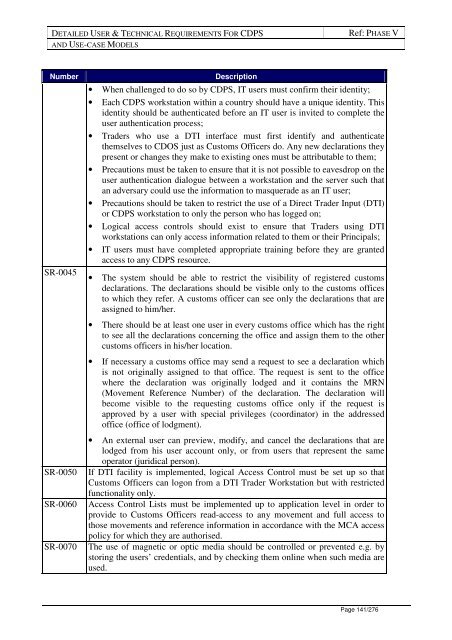Customs Declaration Processing System Detailed User and ...
Customs Declaration Processing System Detailed User and ...
Customs Declaration Processing System Detailed User and ...
You also want an ePaper? Increase the reach of your titles
YUMPU automatically turns print PDFs into web optimized ePapers that Google loves.
DETAILED USER & TECHNICAL REQUIREMENTS FOR CDPS<br />
AND USE-CASE MODELS<br />
Ref: PHASE V<br />
Number<br />
SR-0045<br />
SR-0050<br />
SR-0060<br />
SR-0070<br />
Description<br />
• When challenged to do so by CDPS, IT users must confirm their identity;<br />
• Each CDPS workstation within a country should have a unique identity. This<br />
identity should be authenticated before an IT user is invited to complete the<br />
user authentication process;<br />
• Traders who use a DTI interface must first identify <strong>and</strong> authenticate<br />
themselves to CDOS just as <strong>Customs</strong> Officers do. Any new declarations they<br />
present or changes they make to existing ones must be attributable to them;<br />
• Precautions must be taken to ensure that it is not possible to eavesdrop on the<br />
user authentication dialogue between a workstation <strong>and</strong> the server such that<br />
an adversary could use the information to masquerade as an IT user;<br />
• Precautions should be taken to restrict the use of a Direct Trader Input (DTI)<br />
or CDPS workstation to only the person who has logged on;<br />
• Logical access controls should exist to ensure that Traders using DTI<br />
workstations can only access information related to them or their Principals;<br />
• IT users must have completed appropriate training before they are granted<br />
access to any CDPS resource.<br />
• The system should be able to restrict the visibility of registered customs<br />
declarations. The declarations should be visible only to the customs offices<br />
to which they refer. A customs officer can see only the declarations that are<br />
assigned to him/her.<br />
• There should be at least one user in every customs office which has the right<br />
to see all the declarations concerning the office <strong>and</strong> assign them to the other<br />
customs officers in his/her location.<br />
• If necessary a customs office may send a request to see a declaration which<br />
is not originally assigned to that office. The request is sent to the office<br />
where the declaration was originally lodged <strong>and</strong> it contains the MRN<br />
(Movement Reference Number) of the declaration. The declaration will<br />
become visible to the requesting customs office only if the request is<br />
approved by a user with special privileges (coordinator) in the addressed<br />
office (office of lodgment).<br />
• An external user can preview, modify, <strong>and</strong> cancel the declarations that are<br />
lodged from his user account only, or from users that represent the same<br />
operator (juridical person).<br />
If DTI facility is implemented, logical Access Control must be set up so that<br />
<strong>Customs</strong> Officers can logon from a DTI Trader Workstation but with restricted<br />
functionality only.<br />
Access Control Lists must be implemented up to application level in order to<br />
provide to <strong>Customs</strong> Officers read-access to any movement <strong>and</strong> full access to<br />
those movements <strong>and</strong> reference information in accordance with the MCA access<br />
policy for which they are authorised.<br />
The use of magnetic or optic media should be controlled or prevented e.g. by<br />
storing the users’ credentials, <strong>and</strong> by checking them online when such media are<br />
used.<br />
Page 141/276
















